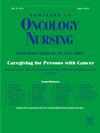多发性骨髓瘤患者和护理者经济负担的不同程度和困难:一项二元定性研究。
IF 2.3
4区 医学
Q1 NURSING
引用次数: 0
摘要
目的:本研究旨在探讨多发性骨髓瘤(MM)患者及其护理人员所经历的多方面经济负担,重点关注直接和间接成本,以及感知经济负担的可变性和不一致性。方法:从韩国首尔的一家三级医院招募40对患者-护理人员进行二元定性研究。采用半结构化访谈法探讨参与者的经济负担经历,并进行主题分析以确定关键主题。还进行了定量分析,以检查临床和社会人口数据。结果:共纳入80名参与者(41名患者和39名护理人员)。患者的中位年龄为70岁,自诊断以来的中位时间为24个月。经济负担分为直接医疗费用和非医疗费用,以及收入损失等间接费用。经济负担的变异性受患者年龄、疾病状态和经济稳定性等因素的影响。护理人员,尤其是成年子女,对长期财务影响有更广泛的看法,而患者则关注眼前的成本。在超过75%的二人组中,明显存在感知负担的不一致,护理人员通常比患者感觉到更重的负担。结论:MM的经济负担是复杂的,并且随着时间的推移而变化,患者和护理者之间的认知存在显著差异。护理人员承担了大量的非医疗和间接成本,而患者则强调直接的经济问题。这些发现突出了家庭范围内的财务咨询和支持的必要性,以解决整个疾病过程中财务毒性的演变性质。对护理实践的影响:护士在解决MM患者和护理人员的经济负担方面发挥着至关重要的作用。他们应该促进开放的沟通,以协调期望,提供财务咨询,并倡导以家庭为中心的护理。通过支持量身定制的干预措施和资源获取,护士可以帮助减轻经济负担,改善患者及其家属的整体福祉。本文章由计算机程序翻译,如有差异,请以英文原文为准。
Different Level and Difficulties with Financial Burden in Multiple Myeloma Patients and Caregivers: A Dyadic Qualitative Study
Objectives
This study aimed to explore the multifaceted financial burden experienced by patients with multiple myeloma (MM) and their caregivers, focusing on direct and indirect costs, as well as variability and discordance in perceived financial burdens.
Methods
A dyadic qualitative study was conducted with 40 patient-caregiver pairs recruited from a tertiary hospital in Seoul, Korea. Semistructured interviews were used to explore participants' experiences with financial burden, and thematic analysis was performed to identify key themes. Quantitative analyses were also conducted to examine clinical and sociodemographic data.
Results
A total of 80 participants (41 patients and 39 caregivers) were enrolled. Patients had a median age of 70 years, with a median time since diagnosis of 24 months. Financial burdens were categorized into direct medical and nonmedical costs, as well as indirect costs such as income loss. Variability in financial burden was influenced by factors such as patient age, disease state, and financial stability. Caregivers, particularly adult children, reported a broader perspective on the long-term financial impact, while patients focused on immediate costs. Discordance in perceived burden was evident in over 75% of dyads, with caregivers often perceiving a heavier burden than patients.
Conclusions
The financial burden of MM is complex and evolves over time, with notable differences between patient and caregiver perceptions. Caregivers bear significant nonmedical and indirect costs, while patients emphasize immediate financial concerns. These findings highlight the need for family-wide financial counseling and support to address the evolving nature of financial toxicity throughout the disease journey.
Implications for Nursing Practice
Nurses play a vital role in addressing the financial burdens of MM patients and caregivers. They should facilitate open communication to align expectations, provide financial counseling, and advocate for family-centered care. By supporting tailored interventions and resource access, nurses can help reduce financial burden, improving the overall well-being of patients and their families.
求助全文
通过发布文献求助,成功后即可免费获取论文全文。
去求助
来源期刊

Seminars in Oncology Nursing
Nursing-Oncology (nursing)
CiteScore
3.40
自引率
0.00%
发文量
68
审稿时长
45 days
期刊介绍:
Seminars in Oncology Nursing is a unique international journal published six times a year. Each issue offers a multi-faceted overview of a single cancer topic from a selection of expert review articles and disseminates oncology nursing research relevant to patient care, nursing education, management, and policy development.
 求助内容:
求助内容: 应助结果提醒方式:
应助结果提醒方式:


